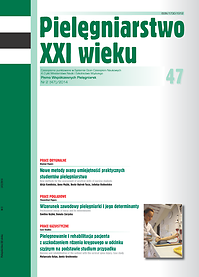Metody monitorowania bólu u noworodków i niemowląt
DOI:
https://doi.org/10.12923/Słowa kluczowe:
ból pooperacyjny, ocena bólu, noworodek, niemowlę, wcześniakAbstrakt
METODY MONITOROWANIA BÓLU U NOWORODKÓW I NIEMOWLĄT
Ból pooperacyjny jest nieprzyjemnym doznaniem, które może pogarszać jakość życia pacjenta, wydłużać proces rekonwalescencji, wydłużać pobyt w szpitalu i zwiększać koszty hospitalizacji. W celu prawidłowego prowadzenia analgezji pooperacyjnej niezbędne jest monitorowanie natężenia bólu z zastosowaniem standaryzowanych narzędzi. Największe wyzwanie dla profesjonalistów medycznych stanowią dzieci poniżej 3 roku życia, które albo jeszcze nie mówią, albo nie potrafią określić intensywności odczuwanego bólu. W związku z tym, personel sprawujący opiekę nad dzieckiem powinien znać podstawowe narzędzia służące monitorowaniu bólu. Celem pracy jest omówienie kilku skal dostosowanych specjalnie dla tej grupy wiekowej oraz przedstawienie najczęściej stosowanych leków analgetycznych.
Bibliografia
1. Stevens B. Pain assessment and management in infants with cancer. Pediatr. Blood Cancer .2007; 49: 1097-1101.
2. Garra G, Singer AJ, Taira BR, et al. Validation of the Wong-Baker FACES Pain Rating Scale in Pediatric Emergency Department Patients. Acad. Emerg. Med. 2010; 17(1): 50-54.
3. Trudeau JD, Lamb E, Gowans M, Lauder G. A prospective audit of postoperative pain control in pediatric patients. AORN. Journal. 2009; 90(4): 531-542.
4. Lönnqvist PA, Morton NS. Postoperative analgesia in infants and children. Br. J. Anaesth. 2005; 95(1): 59-68.
5. Fuller BF. Infant behaviors as indicators of established acute pain. JSPN. 2001; 6(3): 109-115.
6. Prevention and management of pain in the neonate: an update. Pediatrics. 2006; 118 (5): 2231-2241.
7. Pasero C. Pain assessment in infants and young children: neonates. A.J.N. 2002; 102:61-64.
8. Schiavenato M. Facial expressions and pain assessment in the pediatric patient: the primal face of pain. JSPN. 2008; 13(2): 89-97.
9. Stevens B, Johnston C, Petryshen P, et al. Premature Infant Pain Profile: development and initial validation. Clin. J. Pain. 1996; 12(1): 13-22.
10. McNair C, Ballantyne M, Dionne K, et al. Postoperative pain assessment in the neonatal intensive care unit. Arch. Dis. Child. Fetal. Neonatal. Ed. 2004; 89(6): F537-F541.
11. Lawrence J, Alcock D, McGrath P, et al. The development of a tool to assess neonatal pain. Neonatal Network. 1993; 12(6): 59-66.
12. van Dijk M, de Boer JB, Koot HM, et al. The reliability and validity of the COMFORT scale as a postoperative pain instrument in 0 – to 3-year-old infants. Pain. 2000; 84(2-3): 367-377.
13. Merkel SI, Voepel-Lewis T, Shayevitz JR, et al. The FLACC: a behavioral scale for scoring postoperative pain in young children. Pediatr. Nurs. 1997; 23(3): 293-297.
14. Merkel S, Voepel-Lewis T, Malviya S. Pain assessment in infant and young children: the FLACC scale. A.J.N. 2002; 102(10): 55-57.
15. Debillon T, Zupan V, Ravault N, et al. Development and initial validation of the EDIN scale, a new tool for assessing prolonged pain in preterm infants. Arch Dis Child Feta. Neonatal Ed 2001;85: F36 – F41
16. Kohut SA, Riddell RP. Does the Neonatal Facial Coding System differentiate between infants experiencing pain-related and non-pain-related distress? J Pain 2009;10(2): 214– 220.
17. Good practice in postoperative and procedural pain management, 2nd edition. Association of Paediatric Anaesthetists of Great Britain and Ireland. Paediatr. Anaesth. 2012; 22(suppl 1): 1-79.
18. Duggan ST, Scott LJ. Intravenous paracetamol (acetaminophen). Drugs. 2009; 69(1): 101-113.
19. Verghese ST, Hannallah RS. Acute pain management in children. J. Pain. Res. 2010; 15(3): 105-123.
20. Anand KJS. Pharmacological approaches to the management of pain in the neonatal intensive care unit. J. Perinatol. 2007; 27(suppl 1): S4-S11.
Pobrania
Opublikowane
Numer
Dział
Licencja
Prawa autorskie (c) 2014 Ilona Rozalska-Walaszek, Anna Aftyka (Autor)

Utwór dostępny jest na licencji Creative Commons Uznanie autorstwa 4.0 Międzynarodowe.




